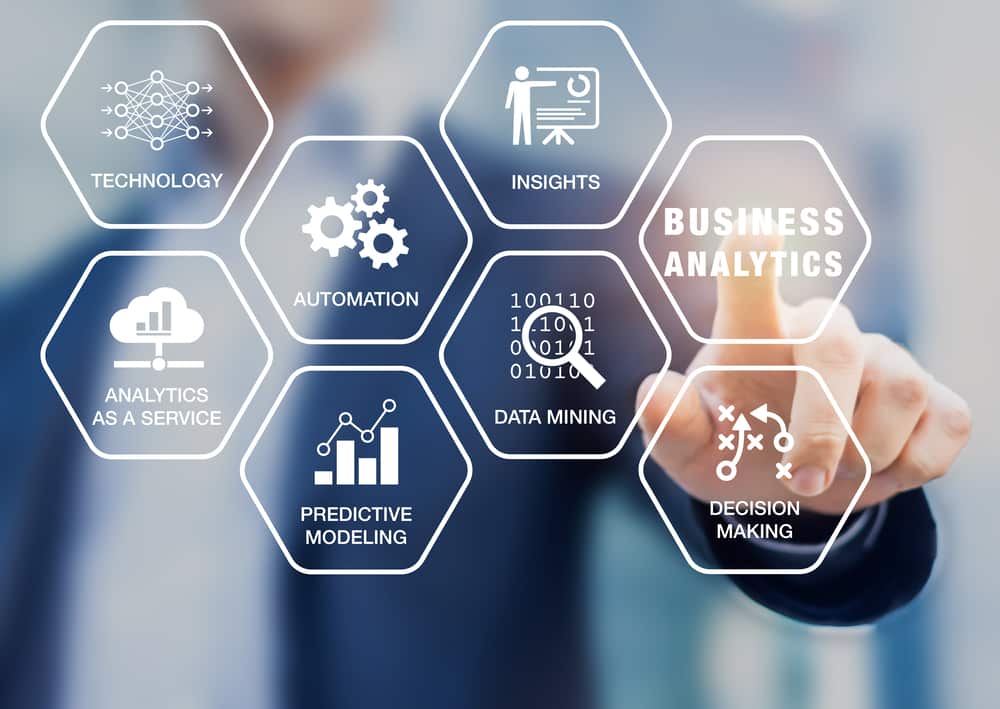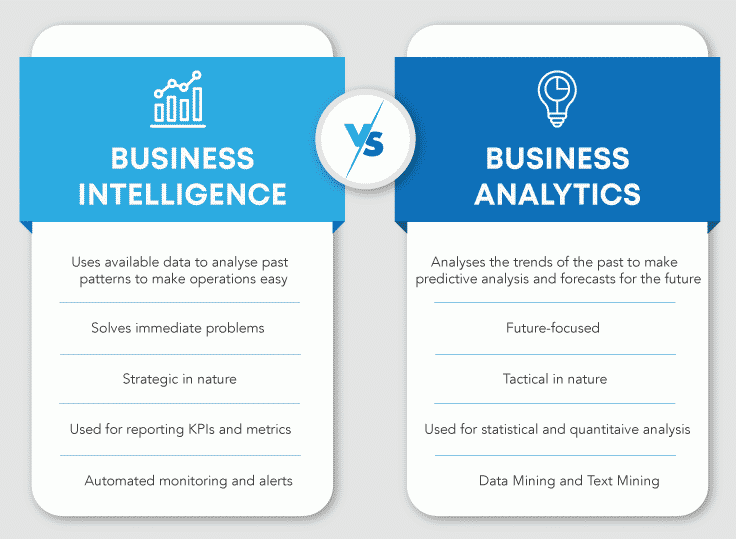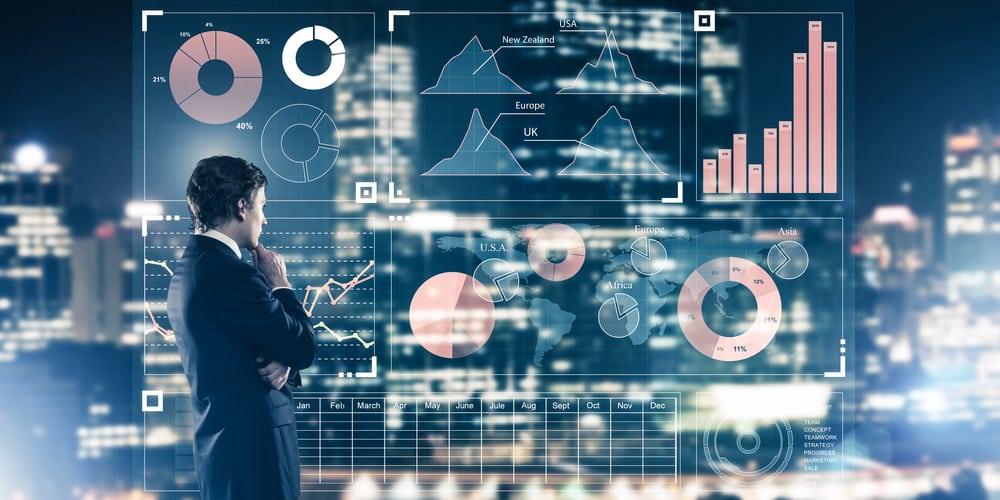- Introduction to Business Intelligence
- An insight into Business Analytics
- Components of Business Analytics
- Applications of Business Intelligence
- Applications of Business Analytics
- Similarities and differences between Business Intelligence and Business Analytics
- Deciding when to apply Business Analytics and Business Intelligence
Introduction to Business Intelligence
Business Intelligence is the aggregate of strategies and technologies used by various businesses to analyse data and extract useful information from it. It also involves elements of data prediction and forecasting by analysing and crunching huge amounts of data. BI makes use of various trends and repetitive patterns to come to a conclusion. Also, it acts as an important decision-making tool that is free from human bias to a great extent.
Business Intelligence involves various processes and frameworks that convert a huge number of raw data files to something which can help the business in several ways. It also facilitates easy and sustainable profits by analysing various parameters and risks associated with the business.
- Business Intelligence transforms numbers into the language of business, thus facilitates easy decision making.
- BI uses various softwares and turns the raw data to a storable intelligence which becomes a crucial part of any business
- It directly affects the strategical, operational and tactical elements of the business, thus becoming an inseparable part of any business in modern times.
- Business Intelligence also uses facts available in the system which results in improved accuracy and also removes the human-error element from any analysis that is done.
- Ultimately, BI is an effective tool for data visualization as it is an interactive model of data analysis. With the visualization of data, BI has become user-friendly and also easy to understand.
An insight into Business Analytics
Business Analytics is defined as the process where the data is cleaned using various statistical tools and models. The data is collated, sorted, processed and then studied by applying various statistical approaches and formulae to be transformed into business insights. These automated tools use correlation, regression and other such well known statistical methods to compare data and then come to a valid conclusion. Business Analytics is a superset of Business Intelligence which specialises in the statistical approach of analysing data to make business decisions. The main aim of Business Analytics is to work towards a specific goal and also to find actionable insights by studying patterns in data. It is method oriented as it makes use of predefined methods to conclude facts and desired results. It is also really effective in making predictive analysis and forecasting future trends and patterns.
Methods
- Makes use of various statistical models to develop an actionable goal.
- Acts as a driving force when the company has to make data-driven decisions.
- Uses operational efficiencies and statistics to understand the complex sets of data and then draws out various patterns accordingly.
- The information received is then used to make business decisions.
Components of Business Analytics
- Data Aggregation: This process involves collecting data using various sources. The data is then centralised and filtered which helps in removing the unwanted and incomplete data sets. The data is cleansed and brought down to a level where it can be used for a particular business. This information either comes from within the company (transactional records) or is shared by the consumers directly through various channels.
- Data Mining: Earlier trends are analysed to understand the current trends in a clearer way. Therefore, relevant data is mined from huge chunks of data. This method makes use of various classification variables such as purchasing patterns, per capita income, demographic factors, geographical factors, etc to sort data. Then the data is used in making predictive analysis with the help of the past trends and then the data is clustered and divided into various groups which makes data analysis easy.
- Forecasting: Forecasting is one of the most important elements of data analytics. The future trends are forecasted based on the prevailing and past trends. Such tools are used in making decisions where the past is driving the whole business. One could predict oil rates based on various economic conditions, etc.
Applications of Business Intelligence
- Visualization: Business Intelligence has made data visualization a cup of tea. It has made the data user-friendly and easy to understand. BI makes use of various software and data analytics tools to present data in a form that makes it easy to use. With the help of visualization of data in the form of bars, graphs, and charts, it has become easy to monitor the manufacturing and logistics, efficiency and productivity of a particular section of the company. Also, the visualization can be customised according to the needs of the user. With this feature, even a newbie can analyse chunks of data in a matter of seconds. Also, our brains are better with visual comprehension compared to textual comprehension.
- Sales Intelligence: BI makes the best use of the data where the business meets the consumers. It collects data on various factors like demographics, geography, demand, etc which drives in the revenue of the company and then finds out various actionable data points giving the company useful insights. This helps the company in understanding their consumers better.
- Reporting: BI has made reporting of information much easier. With BI, unstructured data is processed and then classified into various groups for the ease of decision making. This tool can also be used in analysing various expenses, sales numbers, operational numbers, employee count and productivity. Reporting acts as a closing step once the data is analysed. Summaries are created with the help of processed data which are finally converted into business decisions.
Example
Royal Dutch Shell has brought in a predictive maintenance mechanism driven by Artificial Intelligence. This was done to cut down the time which is lost due to machine failure. The algorithm was used to keep a check on machine valves, compressors, etc and also to ascertain when maintenance of the parts is needed. This has brought down the risk of failure of the system to a bare minimum.
Applications of Business Analytics

Business Analytics is being used in various functional departments and is becoming widely popular due to a variety of uses and the ease of implementing it.
- Finance: BA has gained importance in the field of Finance. Financial Analysts use BA to analyse financial data and make finance-related decisions for the company. Various tools are used in managing portfolios, budgeting, forecasting, etc. These tools are also helpful in deciding the prices of various commodities.
- Marketing: This segment is emerging at a great pace. Marketing uses Business Intelligence to trace consumer patterns and trends to market their products to the right audience. Today, tools, like google trends and google analytics, are used to find the products which are trending among the people and also to analyse and monitor various channels of advertising and how much revenue does each channel brings in.
- Manufacturing: With the use of Business Intelligence, the supply chain efficiencies have improved to a great extent. Also, BA makes inventory management a very simple process. With the help of BA, manufacturing risks are mitigated and efficiencies are improved.
Example
The Coca-Cola Company used business analytics to retain customers. It developed a digital loyalty program to retain customers. It kept the customers tied to the brand. With the help of data, they created relevant content for their consumers to keep them tied to the brand.
Similarities and differences between Business Intelligence and Business Analytics
Similarities
Both of these tools are used for simplifying, processing and analysing data. These tools have become a pivotal point in decision making as strategies are made and operational efficiencies are achieved with both.
Differences
- Business Intelligence makes use of available data to analyse past patterns and make operations simple and easy in the present whereas Business Analytics analyses the trends of the past to make predictive analysis and forecasts for the future.
- BI is used to run the current business smoothly and on the other hand, BA is used to bring changes in the operations.
- Finally, BI is important where the business’s focus is to run the current business whereas BA is applicable where future growth and sustenance are considered to be the topmost priority.

Also Read: Top 10 Business Analytics Companies in India to work for
Deciding when to apply Business Analytics and Business Intelligence
BI does not involve any coding and can be used by various departments with ease. If the present needs of the business have to be optimised, BI is the best way to go about it. If the company is interested in real-time reporting, it should opt for Business Intelligence.
On the other hand, if business processes have to be altered and major changes have to be brought in the system, Business Analytics is the best option. Business Analytics makes data interpretation and data mining easy which will help in the formation of the new processes. Also, if a predictive analysis has to be done and the future results have to be forecasted, BA acts as a mandatory tool to draw conclusions and predict future variables with precision as it makes use of various statistical tools to do so.
If you want to pursue a career in business analytics and looking for courses to upskill? Consider great learning’s PG program in Business Analytics and Business Intelligence and ensure a successful career.








